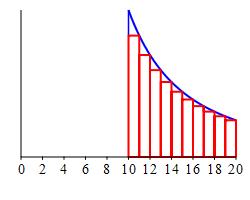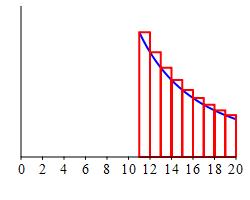20. Convergence of Positive Series
g. Approximating the Series
2. Improved Integral Bounds
Assume \(a_n=f(n)\) where \(f(x)\) is a continuous, positive, decreasing function on \(\lbrack n_o,\infty)\) and \(\displaystyle \int_{n_o}^\infty f(x)\,dx\) is convergent. When the series \(\displaystyle S=\sum_{n=n_o}^\infty a_n\) is approximated by the partial sum \(\displaystyle S_k=\sum_{n=n_o}^k a_n\), the integral \(\displaystyle \int_k^\infty f(x)\,dx\) is an upper bound on the error \(E_k=S-S_k\). However, the approximation to the series can be improved and the error estimate can be vastly reduced if we also use an integral which is a lower bound on the error.
In a previous example, we approximated the series \(\displaystyle S=\sum_{n=1}^\infty \dfrac{1}{n^2}\) by the \(10^\text{th}\) partial sum \(\displaystyle S_{10}=\sum_{n=1}^{10} \dfrac{1}{n^2}\approx 1.5498\) and showed the error \(\displaystyle E_{10}=S-S_{10}=\sum_{n=11}^\infty \dfrac{1}{n^2}\) is less than the integral bound \(\displaystyle \int_{10}^\infty \dfrac{1}{n^2}\,dn=.1\). Improve the approximation by using upper and lower integral bounds on the error \(E_{10}\).
Recall the Derivation of the Integral Test. It can be used to produce both upper and lower bounds on the error, as follows:
In the figure at the right, the area under the blue curve is \(\displaystyle \int_{10}^\infty \dfrac{1}{n^2}\,dn\) while the area under the red rectangles is \(\displaystyle \sum_{n=11}^\infty \dfrac{1}{n^2}\). Thus the integral,

\[ U=\int_{10}^\infty \dfrac{1}{n^2}\,dn=\left[\dfrac{-1}{n}\right]_{10}^\infty =[0] -\left[-\dfrac{1}{10}\right]=\dfrac{1}{10} \] is an upper bound on the error \(\displaystyle E_{10}=\sum_{n=11}^\infty \dfrac{1}{n^2}\).
Similarly, in the figure at the right, the area under the blue curve is \(\displaystyle \int_{11}^\infty \dfrac{1}{n^2}\,dn\) while the area under the red rectangles is \(\displaystyle \sum_{n=11}^\infty \dfrac{1}{n^2}\). Thus the integral,

\[ L=\int_{11}^\infty \dfrac{1}{n^2}\,dn=\left[\dfrac{-1}{n}\right]_{11}^\infty =[0] -\left[-\dfrac{1}{11}\right]=\dfrac{1}{11} \] is an lower bound on the error \(\displaystyle E_{10}=\sum_{n=11}^\infty \dfrac{1}{n^2}\).
Thus the error is bounded by: \[ L \lt E_{10} \lt U \] Since the sum of the series is \(S=S_{10}+E_{10}\), we add \(S_{10}\) to this inequality to get lower and upper bounds on the sum: \[ S_{10}+L \lt S \lt S_{10}+U \] So a better estimate for the sum is the midpoint of the interval \([S_{10}+L,S_{10}+U]\): \[ S\approx\overline{S_{10}}\equiv S_{10}+\dfrac{U+L}{2} \] In this problem \[ \sum_{n=1}^\infty \dfrac{1}{n^2} \approx\overline{S_{10}} =1.5498+\dfrac{\dfrac{1}{10}+\dfrac{1}{11}}{2}=1.6452 \] The error in this approximation is less than half of the width of the interval \([S_{10}+L,S_{10}+U]\): \[ \overline{E_{10}}\equiv S-\overline{S_k} \lt \dfrac{U-L}{2} \] In this problem \[ \overline{E_{10}} \lt \dfrac{\dfrac{1}{10}-\dfrac{1}{11}}{2}\approx.0046 \] Notice, we have reduced the error from \(U=0.1\) to \(\dfrac{U-L}{2}=.0046\).
To summarize (and generalize) these results, we have
Assume \(a_n=f(n)\) where \(f(x)\) is a continuous, positive, decreasing function on \([n_o,\infty)\) and \(\displaystyle \int_{n_o}^\infty f(x)\,dx\) is convergent. In other words, \(\displaystyle S=\sum_{n=n_o}^\infty a_n\) converges by the Integral Test.
For \(k \gt n_o\), let \(\displaystyle U_k=\int_k^\infty f(x)\,dx\) and \(\displaystyle L_k=\int_{k+1}^\infty f(x)\,dx\).
- If the series \(\displaystyle S=\sum_{n=n_o}^\infty a_n\) is approximated by \(\displaystyle S_k=\sum_{n=n_o}^k a_n\), then the error in the approximation, \(\displaystyle E_k=S-S_k=\sum_{n=k+1}^\infty a_n\), is less than \(U_k\).
- If the series \(\displaystyle S=\sum_{n=n_o}^\infty a_n\) is approximated by \(\overline{S_k}=S_k+\dfrac{U_k+L_k}{2}\), then the error in the approximation, \(\displaystyle \overline{E_k}=S-\overline{S_k}\), is less than \(\begin{aligned} \displaystyle \dfrac{U_k-L_k}{2}=\int_k^{k+1} f(x)\,dx \end{aligned}\).
In a previous exercise, we approximated the series \(\displaystyle S=\sum_{n=1}^\infty \dfrac{1}{n^2+1}\) by the \(100^\text{th}\) partial sum \(\displaystyle S_{100}=\sum_{n=1}^{100} \dfrac{1}{n^2+1}\approx 1.066\,724\) and showed the error \(\displaystyle E_{100}=S-S_{100} =\sum_{n=101}^\infty \dfrac{1}{n^2+1}\) is less than the integral bound \(\displaystyle \int_{100}^\infty \dfrac{1}{n^2+1}\,dn\approx .01\). Improve the approximation by using upper and lower integral bounds on the error \(E_{100}\).
The improved approximation is \(\overline{S_{100}}=1.076\,674\)
and the error is \(\overline{E_{100}} \lt 4.95\times10^{-5}\).
The upper bound on the error \(E_{100}\) is \[\begin{aligned} U&=\int_{100}^\infty \dfrac{1}{n^2+1}\,dn=\left.\arctan n\right|_{100}^\infty \\ &=\dfrac{\pi}{2}-\arctan 100\approx 9.9997\times10^{-3} \end{aligned}\] The lower bound on the error \(E_{100}\) is \[\begin{aligned} L&=\int_{101}^\infty \dfrac{1}{n^2+1}\,dn=\left.\arctan n\right|_{101}^\infty \\ &=\dfrac{\pi}{2}-\arctan 101\approx 9.9007\times10^{-3} \end{aligned}\] The improved approximation is \[\begin{aligned} \overline{S_{100}}&=S_{100}+\dfrac{U+L}{2} \\ &=1.066\,724+\dfrac{9.9997\times10^{-3}+9.9007\times10^{-3}}{2} \\ &=1.076\,674 \end{aligned}\] and the error in the improved approximation is \[\begin{aligned} \overline{E_{100}} &\lt \dfrac{U-L}{2} \\ &=\dfrac{9.9997\times10^{-3}-9.9007\times10^{-3}}{2} =4.95\times10^{-5} \end{aligned}\] We have reduced the error from \(U=0.01\) to \(\dfrac{U-L}{2}=4.95\times10^{-5}\).
Heading
Placeholder text: Lorem ipsum Lorem ipsum Lorem ipsum Lorem ipsum Lorem ipsum Lorem ipsum Lorem ipsum Lorem ipsum Lorem ipsum Lorem ipsum Lorem ipsum Lorem ipsum Lorem ipsum Lorem ipsum Lorem ipsum Lorem ipsum Lorem ipsum Lorem ipsum Lorem ipsum Lorem ipsum Lorem ipsum Lorem ipsum Lorem ipsum Lorem ipsum Lorem ipsum